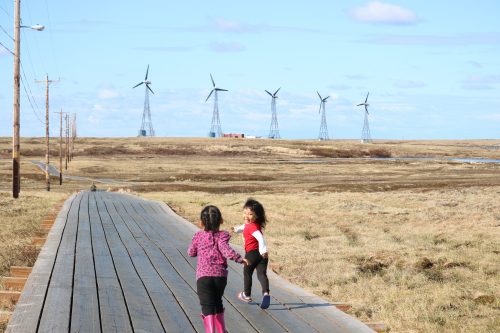Collaboration boosts food, energy, water security in rural Alaska
May 13, 2021
Jeff Richardson
907-474-6284

A new analysis of renewable power in four rural Alaska communities emphasizes the need for more connections between their food, water and energy systems, arguing that such collaboration is a key factor in boosting local security and resilience.
The ongoing study, part of a five-year project funded by the National Science Foundation, looks at how the systems for delivering those resources in rural Alaska work together. That concept, often called the FEW nexus, is part of a broader research trend to recognize how food, energy and water systems can be made more efficient when viewed collectively.
The team’s findings, published in the journal Nature Sustainability, showed that the web of connected systems in rural Alaska extends beyond the FEW nexus. After renewable energy is introduced to a community, issues like transportation and public policy can still strongly influence its ability to enhance food and water security.
But an interconnected view of those systems is uncommon, the study showed. Food, water, energy and transportation systems are often managed separately, allowing limited opportunities for coordination to maximize their benefits.
“It’s important to look at energy impacts on the community holistically,” said co-author Erin Whitney, a researcher at the University of Alaska Fairbanks’ Alaska Center for Energy and Power who leads the study. “What we really need to do is empower local leaders to do that.”
The research team looked at four communities off the Alaska road system — Igiugig, Tanana, Kongiganak and Cordova — that use a renewable source for energy generation.
In each case, renewable energy offered the potential for broader benefits. Excess electricity could be used to heat thermal stoves or grow produce in greenhouses, for example, and gathering wood for biomass systems provided scarce local jobs. But the availability of good transportation, such as direct flights to Igiugig or ferry service to Cordova, was also an outsized factor in local costs. Public subsidies for mail and power also played significant roles.
The research team included an interdisciplinary group of engineers, social scientists and Indigenous community leaders. That broad perspective, as well as input from various community members, underscored the conclusion that rural systems need to be more interconnected to function well.
“As we know, in rural Alaska, security in any of these domains is not always that high,” said Henry Huntington, an independent researcher and lead author of the paper. “The idea is to show that these are all closely connected and that it doesn’t make sense to think of these things one at a time.”
Other contributors to the study included UAF researchers Srijan Aggarwal, Amanda Byrd, Subhabrata Dev, Daisy Huang, Barbara Johnson, Justus Karenzi, William Schnabel, Richard Wies Jr. and Michelle Wilber; Aaron Dotson and Jennifer Schmidt, University of Alaska Anchorage; Philip Loring, University of Guelph; Henry J.F. Penn, University of Calgary; AlexAnna Salmon, Igiugig Village Council; and Daniel J. Sambor, Stanford University.
ADDITIONAL CONTACT: Erin Whitney, 907-799-6724, erin.whitney@alaska.edu; Henry Huntington, 907-696-3564, henryphuntington@gmail.com
NOTE TO EDITORS: Videos and summaries of each community project are available online at https://ine.uaf.edu/projects/microfews/communities/.


